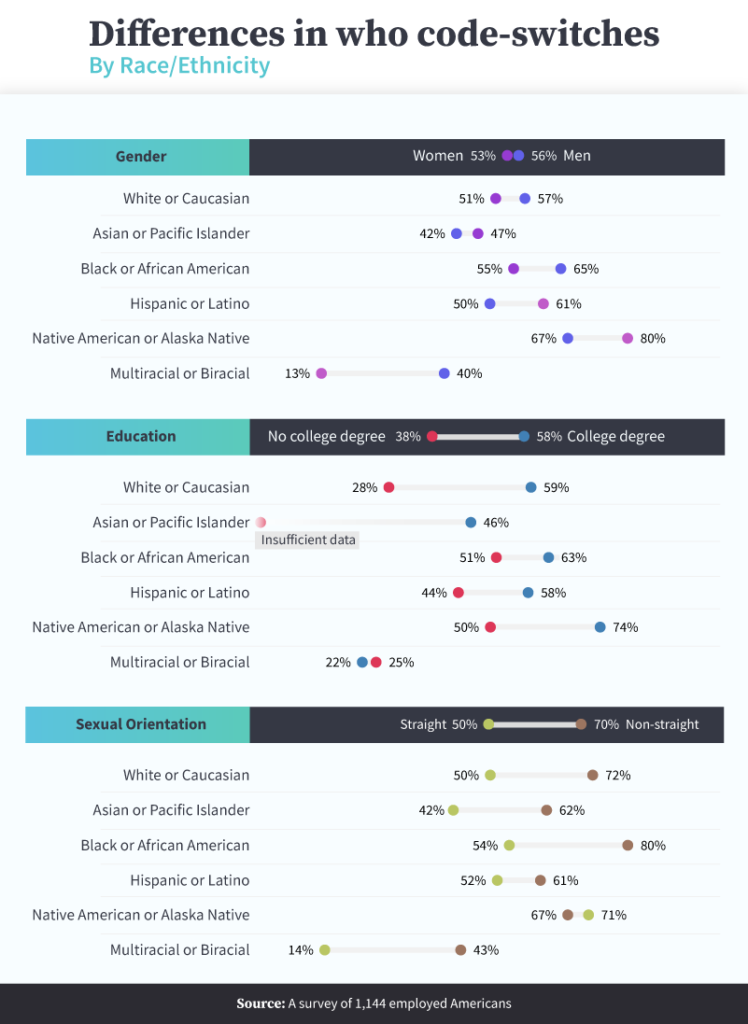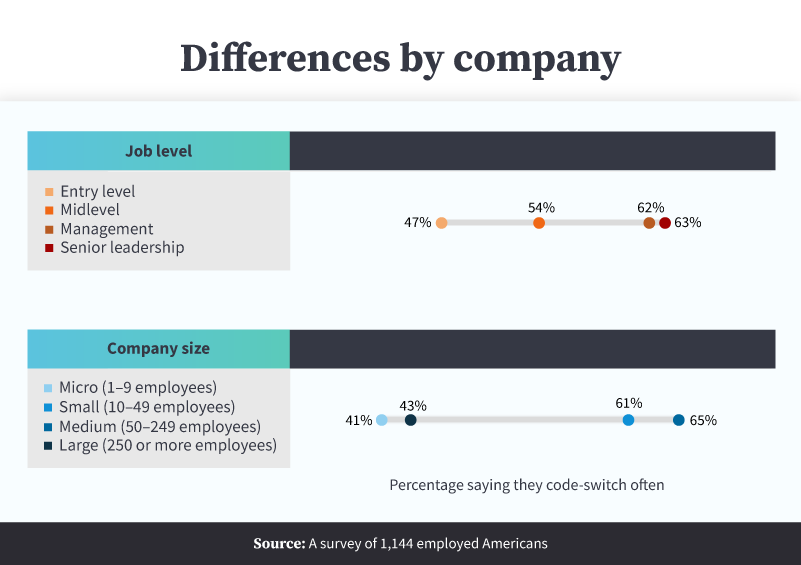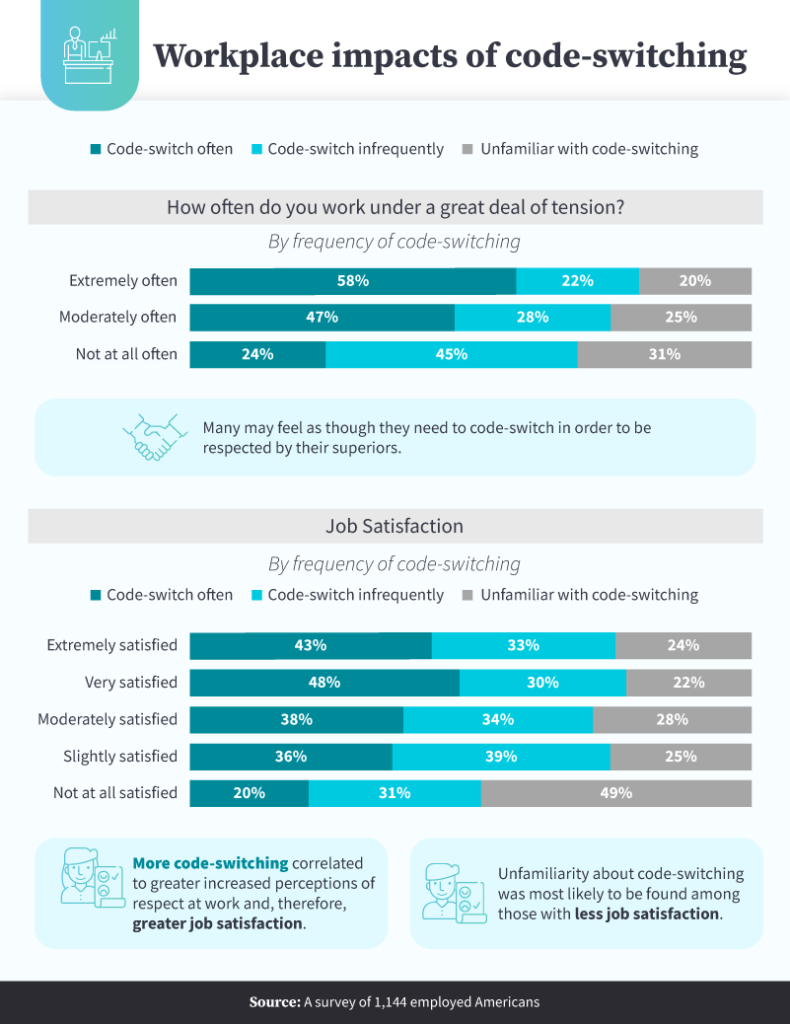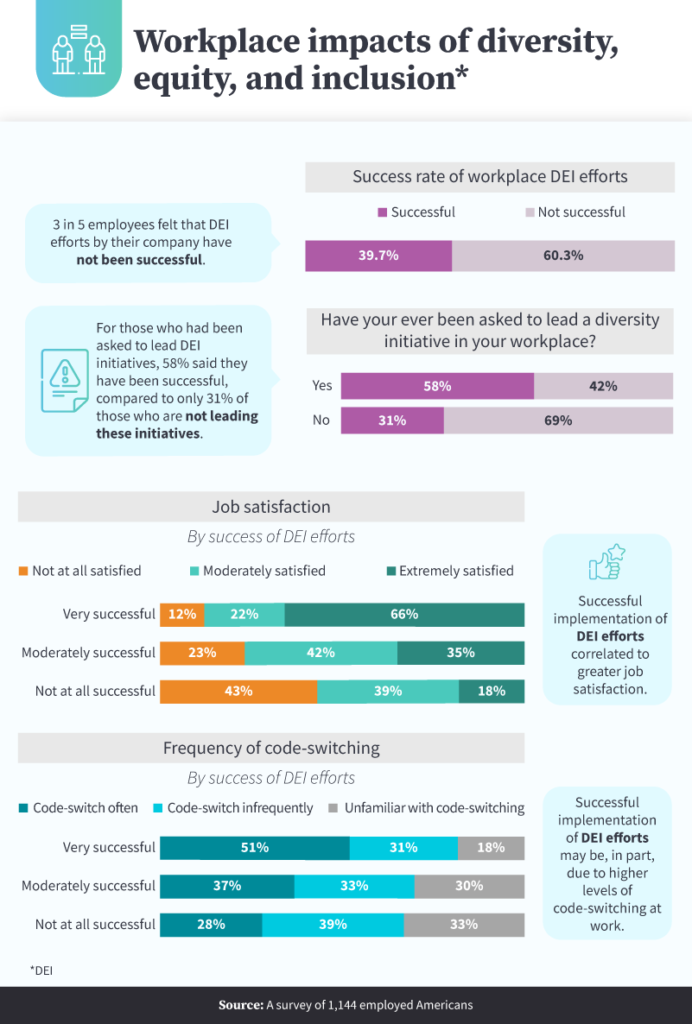
By Jeff Gillis & Mike Simpson
When you think of your place of work, do you feel that you truly “fit in?” If you find yourself changing pieces of who you are, like the way you speak or express yourself, you may actually be doing what’s known as “code-switching.” With an emphasis on linguistics and verbal communication, code-switching refers to the process of shifting your methods of expression depending on the social context. In the office, this happens quite a bit, particularly for minority groups.
While conversations centering on racism have finally started to take center stage, it’s important to recognize code-switching as an incredibly important piece of that conversation. Which groups are changing which forms of expression in the workplace? And how does this impact their ability to perform, their likelihood to be promoted, and their overall job satisfaction? We recently spoke to 1,144 employed Americans of different races and orientations to find out. They shared some shocking pieces of information but hopefully ones from which we can learn and grow. To do exactly that, keep reading.
Understanding Code-Switching
In addition to the technical definition, code-switching comes with more nuanced understandings, especially in the workplace. Our study kicks off with a look at the ways in which various groups have come to understand code-switching and how frequently related behaviors play out in the office.

With regards to race, the burden of code-switching fell primarily on Black or African Americans and Native Americans and Alaska Natives. These respondents were much more likely than their white counterparts to say they “often” code-switch in their place of work. As one Black researcher explained to Harvard Business Review, “At this point in my career, code-switching feels natural. I am not even cognizant that I do it anymore.”

In spite of this normalization of code-switching, minority respondents were still highly aware of its meaning. Marginalized groups demonstrated a much higher awareness of what code-switching even meant. Just a small 8% of Black or African American respondents didn’t know what code-switching meant, compared to nearly a third of white or Caucasian respondents who didn’t grasp its meaning.
But the burden of code-switching grew even more when we looked beyond race and into sexual orientation. The largest discrepancy between those who code-switched and those who did not came between straight and non-straight respondents. Even in these “modern” times, as many as 50% of LGBTQ Americans report feeling obligated to stay in the closet in their places of work, due in part to the lack of universal legal protection against this type of discrimination.

Results of Code-Switching
With so many respondents having personally experienced code-switching at work, we wanted to know how this was impacting their job experience. This next piece of our study looks at the impacts of code-switching on workplace stress, job satisfaction, and respect.

Code-switching was ultimately a degrading experience for most but one that still felt necessary to get ahead. Those who changed their mannerisms and forms of expressions to fit in were much more likely to report feelings of tension. Fifty-eight percent of those who said they very often worked under a great deal of tension said they frequently code-switched at work, compared to only 24% of those who said they did not work under tension at all. Many also felt an obligation to code-switch in order to be respected by their co-workers and superiors.
The assumption that code-switching was necessary for respect is unfortunately true in today’s society. Evidence also revealed that code-switching did make respondents more likely to be promoted, which can be a key indicator of respect. While code-switching is clearly a negative concept, the environment in which it occurs is clearly favoring the behavior. Even worse, the promotions that code-switching helped induce weren’t often correlated with raises. This partially explains the still persistent wage gap between races, which is thought to be even worse today than it was in the year 2000.
The Personal Costs of Code-Switching
In spite of the staggering numbers of people who feel inclined to code-switch at work, it’s often the individual stories and impacts that leave a lasting impression. In fact, individual stories are remembered 22 times as often as statistics. The next piece of our study looks at the personal impacts that code-switching had on respondents in terms of emotions like anxiety and burnout.

In no uncertain terms, code-switching leads to higher rates of depression, burnout, anxiety, and worry. Respondents who code-switched at work were highly likely to experience these emotions as often as six or seven days out of the week, indicating an emotional impact carried outside of the workplace. For instance, people who reported code-switching often had a 60% chance of feeling unable to stop worrying six to seven days out of the week.
These feelings have only been amplified in recent years. Especially with COVID-19, rates of depression have tripled in the U.S. Ironically, those who remained employed during the pandemic were considered some of the lucky ones. But as our evidence reveals, maintaining employment under the pressures of code-switching induces many of the same stressors caused by unemployment. While it’s important to care about the well-being of employees strictly from an ethical perspective, the financial fallout from a business perspective can also be detrimental. Unhappy workers are proven to be less productive and less effective, costing the U.S. an estimated $550 billion in financial losses each year.
Code-Switching Remedy Attempts
Efforts for Diversity, Equity, and Inclusion – shortened to DEI – are important and perhaps improving, yet have often been unsuccessful in the past. Code-switching, after all, is still incredibly common. In an effort to improve DEI incentives, we wanted to understand just what was working and what wasn’t. This last part of our study looks into the perceived impacts of DEI efforts among a diverse group of employed Americans.

Respondents ultimately echoed the sentiments of previous research on DEI efforts: 3 out of 5 found them unsuccessful. Interestingly, however, this diverse group had not often been included in leading the efforts, and when they were able to lead, found them to be much more successful. Perhaps DEI efforts’ lack of success is due to a lack of diversity in their leadership. According to Fast Company, including employees in the leadership is an important step to helping ensure your company’s DEI efforts don’t flop.
Getting DEI efforts right was also incredibly impactful. Those who experienced successful implementation of DEI efforts demonstrated higher levels of job satisfaction and a better understanding of what code-switching meant. Respondents who reported code-switching often were also more likely to perceive a successful outcome of DEI activities, which may indicate that the more these efforts are needed, the easier it is for them to be considered a success.
Looking at Next Steps
Evidence of code-switching was unfortunately not difficult to find. Many respondents – particularly Black, African American, Native American, and Alaska Native respondents – had firsthand experience with the behavior and noted its impacts on depression, anxiety, and burnout.
While DEI efforts continue to improve, The Interview Guys would like to do their part as well. The Interview Guys offer career support from resume creation through interviewing and job performance, regardless of your race, gender, or sexual orientation. If you could use support in your own efforts to change workplace culture or find a new, more inclusive place of work, we are here to help. Just head to theinterviewguys.com so we can lend a hand.
Methodology and Limitations
We collected 1,144 responses of employed Americans from Amazon Mechanical Turk and Prolific. 58% of our participants identified as men, 41% identified as women, and less than 1% identified as nonbinary or nonconforming. Participants ranged in age from 18 to 77 with a mean of 36 and a standard deviation of 10.7. Those who reported no current employment or who failed an attention-check question were disqualified.
The sample size of Native Americans and Alaska Natives was 30 people, as was the sample size for multiracial individuals. Since racial groups should not be analyzed simply as monoliths, it is likely that with more participants, we could have gained more accurate insight into these populations. No statistical testing was performed, so the claims listed above are based on means alone. As such, this content is purely exploratory, and future research should approach this topic in a more rigorous way.
The data we are presenting rely on self-report. There are many issues with self-reported data. These issues include, but are not limited to, the following: selective memory, telescoping, attribution, and exaggeration.
Fair Use Statement
How do you feel about the need to code-switch in the workplace? If you’d like to continue this conversation with your coworkers, feel free to share this article. We just ask that you do so for noncommercial use only and to provide a link back to the original page so contributors can earn credit for their work.